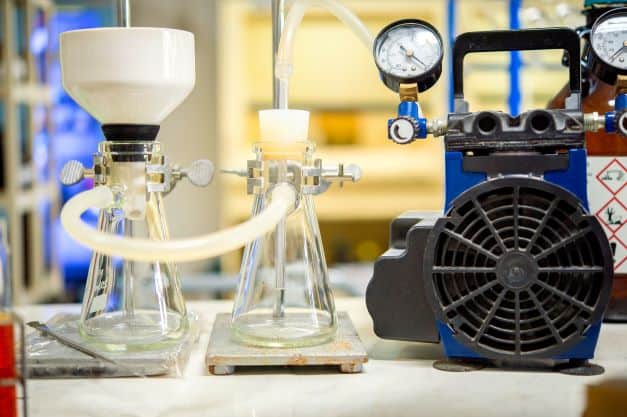A vacuum pump system is a device that helps remove the air and other gases from a container to create a vacuum. It’s widely used in many industries, such as medical, food processing, packaging, pharmaceuticals, cosmetics, printing, and semiconductor manufacturing. From rotary evaporators and freeze dryers to electron microscopes and sputter coaters, vacuum pumps are essential equipment in any laboratory.
Companies like KNF offer a wide range of different vacuum pump technologies. As such, choosing the right system for your lab can be overwhelming. But, don’t fret! This article will narrow down the options and help you select the best vacuum pump system for your needs.
Here are a few factors to consider:
1. Know The Pump Application
First and foremost, it’s crucial to know how the vacuum pump will be used in your lab. There are many different types of vacuum pumps available on the market, each designed for a specific application. For example, a rotary vane pump is typically used for light-duty applications, such as filtration or aspiration. On the other hand, a scroll pump is best suited for heavy-duty applications that require high vacuum levels, such as freeze-drying or sputter coating.
Having a clear understanding of the application will help you choose the right vacuum pump system for your needs. After all, you wouldn’t want to end up with an unsuitable pump for the task at hand!
2. Consider The Pumping Speed
The pumping speed of a vacuum pump is another key factor to consider. It’s typically measured in liters per second (L/s) or cubic feet per minute (CFM). A higher pumping speed indicates that the pump can remove more air from the container in less time.
A vacuum system with a pumping speed of 50 L/s is sufficient for most applications. However, if you’re working with a large container or need to achieve high vacuum levels, you may need a pump with a higher pumping speed.
Keep in mind that the pumping speed of a vacuum pump isn’t constant. It’ll vary depending on the pressure inside the container. As such, it’s essential to choose a pump with a wide range of pumping speeds. This will ensure that the pump can maintain a constant flow, even as the pressure changes.
3. Determine The Vacuum Level Required
The vacuum level is the amount of negative pressure the pump can create inside the container. It’s typically measured in millimeters of mercury (mmHg) or inches of mercury (inHg).
The vacuum level you need will depend on the application. Some applications, such as filtration or aspiration, only require a low vacuum level (e.g., 10 mmHg). Others, such as sputter coating or freeze-drying, require a high vacuum level (e.g., 760 mmHg).
To determine the vacuum level required for your application, consult your lab’s specifications or the manufacturer of the equipment you’re using. This way, you can ensure that the pump you choose can generate the necessary vacuum level.

4. Familiarize The Different Types Of System
There are many different types of vacuum pump technologies available on the market. The most common types are rotary vane pumps, scroll pumps, diaphragm pumps, liquid ring pumps, and turbomolecular pumps. And, each has its own specific features that you’ll want to consider.
Here’s a quick overview of each one:
- Rotary vane pump
A rotary vane pump is the most popular type of vacuum pump. It usually works using an eccentric rotor to push air out of the pump chamber. This design makes the pump very efficient and allows it to achieve a high pumping speed. Additionally, this pump system has less noise and requires little maintenance.
- Scroll pump
Scroll pumps use two spiral-shaped scrolls instead of an eccentric rotor. As the scrolls rotate, they create pockets of vacuum that pull air into the pump. This feature is one of the main advantages of scroll pumps as it allows them to run for a long time without losing their performance.
- Diaphragm pump
This system uses a diaphragm (a flexible membrane) to separate the pumping chamber from the atmosphere. As the diaphragm expands and contracts, it pumps air out of the chamber. Diaphragm pumps are very compact and also require little maintenance.
- Liquid ring pump
This pump uses a rotating impeller to create a liquid seal. As the impeller rotates, it forces the liquid (usually water) to form a ring around the pumping chamber. This liquid ring creates a seal that prevents air from entering the chamber. Liquid ring pumps are often used in applications where corrosive or flammable gases need to be pumped.
- Turbomolecular pumps
Turbomolecular pumps use a series of rotating blades to create a vacuum. The blades create a low-pressure zone that pulls air into the pump. The operating speed of turbomolecular pumps is extremely fast, making them ideal for applications that require a high vacuum level.
5. Evaluate The Device Manufacturer
The device manufacturer is just as important as the vacuum pump system itself. You’ll want to make sure that the company you choose is reputable and has a good track record. That means they deliver high-quality products and offer fair prices.
Additionally, a product warranty is also an important factor to consider. This approach will give you peace of mind, knowing that you’re covered if the pump breaks down or doesn’t meet your expectations. After all, it’s a significant investment for your lab.
Takeaway
Now that you know several factors to consider when choosing a vacuum pump system for your lab, it’s time to put this knowledge into practice. Use the tips outlined here, and you’ll be sure to find a pump that meets your requirements and provides the performance you need.







